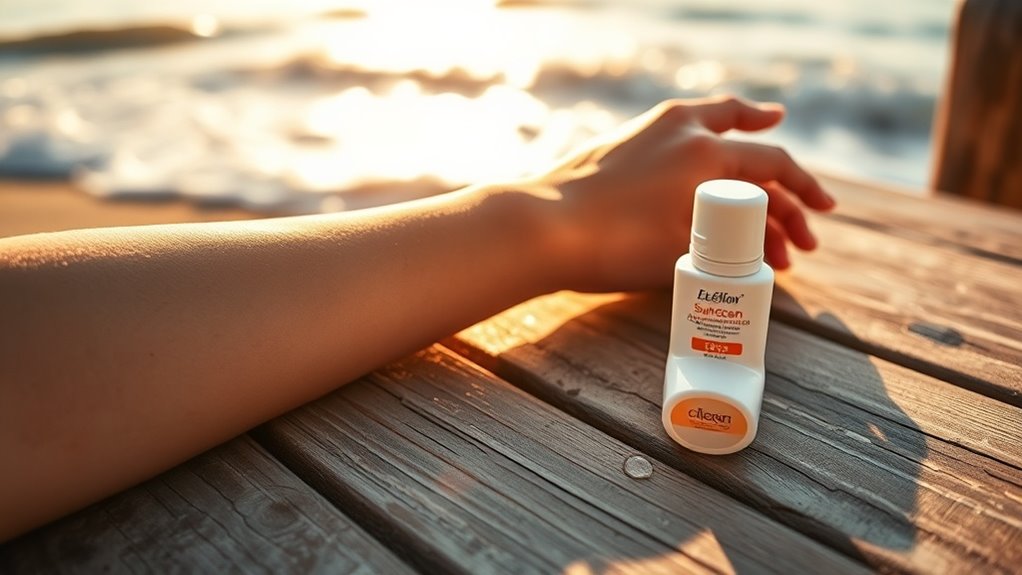Why SPF Is Your Best Weapon Against Dark Spots
If you’re concerned about dark spots on your skin, understanding the protective role of SPF is essential. These spots can result from various factors, including UV rays that cause damage and hyperpigmentation. By applying a broad-spectrum SPF, you can effectively safeguard your skin from these harmful rays. But which SPF is right for you, and how can you incorporate it into your routine? Let’s explore these critical aspects of skincare together.
Understanding Dark Spots: Causes and Formation
Dark spots, often referred to as hyperpigmentation, can develop for several reasons, affecting individuals of all skin types.
Factors like sun exposure, hormonal changes, and inflammation contribute to their formation. To prevent these spots, applying SPF daily is crucial. Using an effective sunblock protects your skin from UV rays, reducing the risk of dark spots while promoting an even complexion. Regular application of sunscreen is essential to maintain youthful skin and combat hyperpigmentation.
The Role of UV Rays in Skin Damage
When you spend time in the sun, UV rays penetrate your skin, leading to various forms of damage. Understanding these effects is crucial for prevention.
-
They can cause premature aging, including wrinkles and loss of elasticity.
-
UV rays can trigger inflammatory responses, worsening existing skin conditions.
-
Prolonged exposure can lead to DNA damage, increasing skin cancer risks.
-
Regularly applying daily sunscreen can significantly reduce the risks associated with UV exposure.
How SPF Prevents Dark Spots
Protecting your skin with SPF is a vital strategy in preventing dark spots, a common consequence of UV exposure.
SPF works by absorbing or reflecting harmful UV rays, reducing their penetration into your skin. This minimizes DNA damage in skin cells, which can lead to hyperpigmentation.
Consistent use of SPF helps maintain an even skin tone and reduces the risk of developing dark spots over time.
Choosing the Right SPF for Your Skin Type
How do you know which SPF is best for your unique skin type? Start by considering your skin’s specific needs.
Different formulations suit various types, ensuring you receive optimal protection.
-
Oily skin: Look for gel-based, non-comedogenic SPFs.
-
Dry skin: Opt for hydrating cream-based formulas.
-
Sensitive skin: Choose mineral-based SPFs with fewer irritants.
Selecting the right SPF is crucial for effective sun protection. Additionally, understanding hormonal impacts on your skin can help inform your choice of SPF, as different skin types may react variably to sun exposure.
Incorporating SPF Into Your Daily Routine
Incorporating SPF into your daily routine is essential for maintaining healthy skin and preventing dark spots. Aim for a broad-spectrum SPF of at least 30. Apply it every morning, even on cloudy days. Reapply every two hours when outdoors. Below is a helpful guide for proper SPF application:
| Step | Action | Timeframe |
|---|---|---|
| Cleanse | Wash your face with a gentle cleanser | Daily, AM |
| Apply SPF | Use a nickel-sized amount on face | Daily, AM |
| Makeup | Allow SPF to absorb before makeup | 10 mins |
| Reapply | Use a spray or powder SPF during the day | Every 2 hours |
| Hydrate | Keep skin moisturized for optimal protection | Daily, AM/PM |
Additional Tips for Maintaining an Even Skin Tone
While consistent SPF use is crucial for preventing dark spots, it’s equally important to adopt other practices that promote an even skin tone.
Consider these tips to enhance your skincare routine:
- Exfoliate regularly to remove dead skin cells and encourage cell renewal.
- Stay hydrated to maintain skin elasticity and vibrancy.
- Incorporate antioxidants to combat free radicals and improve overall skin health. Additionally, regular exfoliation can lead to a brighter, smoother appearance and a vibrant glow.

